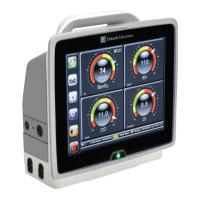35
HemoSphere Advanced Monitor 2 Safety and Symbols
• If the oximetry cable is being transferred from a HemoSphere advanced monitor to another
HemoSphere advanced monitor, check that the patient height, weight, and BSA are correct prior to
beginning monitoring. Re-enter patient data, if necessary. (chapter 11)
• Exercise caution when using dP/dt in patients with severe aortic stenosis, since the stenosis may
reduce the coupling between the left ventricle and the afterload. (chapter 12)
• The P(↓BP) parameter information provided in Tables 12-7 and 12-8 is presented as general
guidance and may not be representative of individual experience. A review of the patient’s
hemodynamics is recommended prior to initiating treatment. See Clinical Application on page 158.
(chapter 12)
• Clean and store the instrument and accessories after each use. (appendix F)
• Do not pour or spray liquid on any portion of the HemoSphere advanced monitor, accessories,
modules, or cables. (appendix F)
• Do not use any disinfecting solution other than the types specified. (appendix F)
• DO NOT: Allow any liquid to come in contact with the power connector Allow any liquid to
penetrate connectors or openings in the monitor case or modules If any liquid does come in contact
with any of the above mentioned items, DO NOT attempt to operate the monitor. Disconnect
power immediately and call your Biomedical Department or local Edwards representative.
(appendix F)
• Conduct periodic inspections of all cables for defects. Do not coil cables tightly when storing.
(appendix F)
• Do not steam, radiate, or EO sterilize the HemoSphere oximetry cable. Do not immerse the
HemoSphere oximetry cable. (appendix F)
• If any electrolytic solution, for example Ringer’s lactate solution, is introduced into the cable
connectors while they are connected to the monitor, and the monitor is turned on, the excitation
voltage can cause electrolytic corrosion and rapid degradation of the electrical contacts. (appendix
F)
• Do not immerse any cable connectors in detergent, isopropyl alcohol or glutaraldehyde. (appendix
F)
• Do not use a hot air gun to dry cable connectors. (appendix F)
• Recycle or dispose of the lithium-ion battery in accordance to all federal, state, and local laws.
(appendix F)
• The instrument has been tested and complies with the limits of IEC 60601-1-2. These limits are
designed to provide reasonable protection against harmful interference in a typical medical
installation. This equipment generates, uses and can radiate radio frequency energy and, if not
installed and used in accordance with the instructions, may cause harmful interference to other
devices in the vicinity. However, there is no guarantee that interference will not occur in a particular
installation. If this equipment does cause harmful interference to other devices which can be
determined by turning the equipment off and on, the user is encouraged to try to correct the
interference by one or more of the following measures: · Reorient or relocate the receiving device.
· Increase the separation between the equipment. · Consult the manufacturer for help. (appendix G)
Status = Released Printed Date: 2018-01-16 Released Date: 2017-09-14

